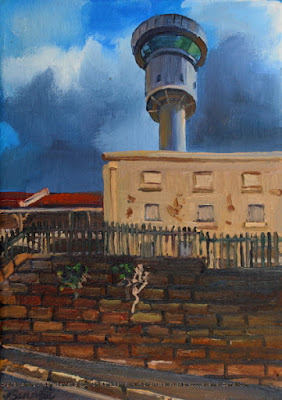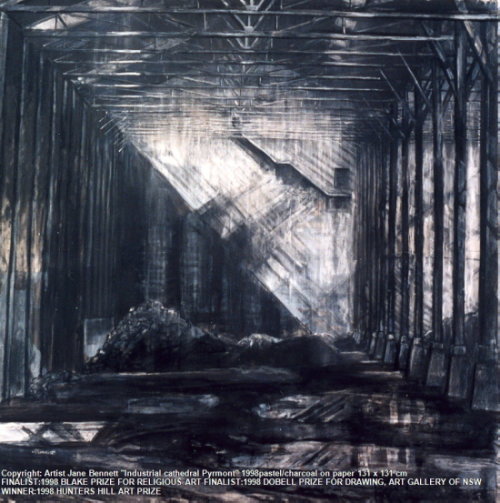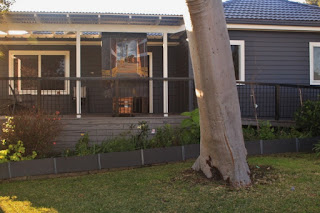The Sydney Harbour Control Tower, which lingered for a while at the northern end of Barangaroo, was demolished over a period of eight months starting in March 2016.
Consisting of an 87m high concrete column topped by an observation room with utterly breath-taking views, it gave the Harbour Master and Port Operations officers an ideal position from which to oversee shipping movements around Sydney Harbour.
The tower was designed in 1972 after two ships collided in the shipping channel off the knuckle of the wharf at Millers Point.
It stood sentinel over Sydney Harbour from 1974-2011 giving continual supervision of shipping movements.
Sydney Ports relocated its harbour control operations to Port Botany in April 2011, leaving the tower to gather dust for 5 years.
I am naturally biased - I had the run of the Harbour Control Tower as a studio for nearly a decade.
As well as painting spectacular views of Sydney from the top floor and the amenities level, I used it as a sort of exclamation point in many landscapes of the wharf and Millers point. This canvas of the empty wharf has the strange melancholy of a de Chirico and the light poles marching steadily toward the Tower echo rows of classical columns.
As a pictorial device, the Tower would give an otherwise mundane streetscape an extra frisson. The feeling of someone potentially observing the scene from above from those green angled windows gave an almost sinister dimension.

MP5 Harbour Tower & Dalgety Terrace 2
The developers of Barangaroo had considered it an eyesore as the surrounding development transformed the former port into a millionaire’s playground.
Former Prime Minister Paul Keating, self-appointed Baron Haussman of Sydney, and never one to shy away from an argument, stated with his customary belligerence that the tower did not have a "shred of heritage about it" and that calls to keep it were "rancid reactionism".
But he would, wouldn't he.
After the Heritage Minister decided not to list the tower on the State Heritage Register, the NSW Government approved a development application from the Barangaroo Delivery Authority to remove the former Harbour Control Tower . In their words : 'in order to achieve a naturalistic form and character for the reserve that is consistent with the site’s concept plan'.
I can't think of anything less naturalistic than Barangaroo. For some reason it brings to mind a poem called aptly "Poetry" by Marianne Moore about an imaginary garden that had real toads in it.
But as in the poem, the developers and their cheerleaders have little time for anything that doesn't fit their very narrow definition of what is "useful". Certainly nothing as useless as heritage.
'same thing may be said for all of us—that we
do not admire what
we cannot understand.'
Excerpt from
"Poetry" by Marianne Moore
The National Trust rejected a proposal by the Barangaroo Delivery Authority to demolish the tower while the City of Sydney council wanted it retained as an artwork or public lookout.
Some people suggested alternate uses for the empty tower: bungee jumping, abseiling, a viewing tower over Sydney Harbour, or a “pop-out” café.
However the Barangaroo Reserve project director Peter Funder said “We looked at a number of re-use options and it just wasn’t viable. It completes the vision we’re trying to deliver here of recreating the headland of Barangaroo.”
As for arguments about usefulness, you could also question what practical use does the Barangaroo Headland Park serve. It has allegedly been returned to the 1836 footprint, yet it is far from natural bushland, and the public certainly isn't permitted to hunt or fish there. So it is a construct - just as artificial as the concrete wharf it replaced.
This canvas painted in 2015 from the Stamford on Kent shows rows of lollipop like palm trees perched tier upon tier, as though on a giant wedding cake. The stairway to the top cuts through the cake like a knife cutting a slice out of the cake. Symmetrical and hierarchical, and as unlike real bushland as the horses on a carousel are from the living animals.

MP45 Barangaroo Headland Park from the
Stamford on Kent 2015 oil on canvas 122 x 153cm
COLLECTION: MITCHELL LIBRARY, STATE LIBRARY OF NSW
Enquiries
Its main function seems to be as a distraction from the scale of the southern end.
A spoonful of sugar to make the development go down.
A sort of 'Trojan park' under which is smuggled the true purpose of Barangaroo; to separate punters from their money.
It's a pity that almost all evidence of Sydney as an industrial port has been wiped away. I certainly found poetry in it.
I can't get used to the lack of Tower in the streetscapes of Millers Point - they look strangely empty now.
Related Posts



















